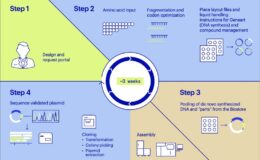

Depositphotos
With the rise of molecular electronics technologies, where will the rapidly emerging DNA revolution take us?
Introduction
In nature, virtually all electronic processes seem to occur in molecular structures. Since the tools of molecular synthesis are rapidly evolving, the emerging application of molecular building blocks for the manufacture of electronic components is gaining ground.
Molecular electronics broadly uses either single molecules or nanoscale collections of single molecules as electronic components, and great efforts are being made to duplicate the capabilities of silicon-based circuitry at the molecular level. This is crucial to understand since current microprocessors are reaching their physical limits, and there is a need to evaluate all available molecules that can be effectively used. It seems there is a growing interest in using DNA to generate molecular changes never achieved before. Organic molecules seem to bring great benefit as the functional center of molecular electronics, primarily due to their low cost, smaller size, strength, and other beneficial capabilities.
The DNA Economy and Emerging Revolution
When the emerging advances in nanotechnology, complementary metal-oxide semiconductor technology (CMOS technology), material sciences, and molecular biology merge and converge to bring us disruptive DNA technological transformation potential, the imminent DNA economy seems revolutionary.
Moreover, genomics, the science of reading and interpreting the genetic sequences encoded in DNA that can be applied to both short and very long sequences in humans and all living beings, is also enhancing the DNA revolution potential. It is, therefore, essential to understand and evaluate:
● Where is the DNA revolution taking us?
● Where can it be applied?
● How will the DNA economy unfold?
DNA is rapidly becoming an accessible and affordable molecular transformation resource. The democratization of DNA accessibility further drives the potential of accelerating a wide variety of application areas for cheaper, faster, and more computing power. This will not only direct drug discovery potential, but it will also accelerate building DNA based data storage and much more.
DNA Microprocessors
While silicon microprocessors have so far been at the heart of the computing world, they are reaching their physical limit. With on-going challenges of physical speed, energy efficiency, and miniaturization limitations of silicon microprocessors, there is a need to find alternatives. DNA is emerging as the alternative and has the potential to take computing to new levels. Moreover, with the cheap supply of DNA and the evolving DNA manufacturing processes, the process to develop DNA chip is becoming much cleaner and realistic. DNA-based computers will not only make computers smaller, but they will hold more data as well. The DNA microprocessors are transformative.
DNA Storage
The prospect of DNA data storage is no longer theoretical. Reports are emerging of enormous data storage capabilities in DNA. DNA can easily store more data and information than the entire collection of computers manufactured. Also, it is believed that the computing power of a droplet of a DNA computer will likely be more powerful than any supercomputer. With trillions of DNA molecules fitting into a mere cubic centimeter, DNA can hold ten terabytes of data and can perform trillions of calculations. While the experimentation still continues, it seems the future of DNA data storage is already here.
It is expected that the most significant advantage of the DNA chip will be parallel processing. DNA computers will be able to do more than one calculation in parallel. This is a limitation of conventional computers that operate linearly and can take hundreds of years to perform complex calculations. It is this promise of parallel computing that is proving to be genuinely revolutionary. As DNA seems to be emerging as a new unit to store data and to build a new economy, reports are already emerging of Microsoft using DNA to solve the data storage crisis.
Need for DNA Reading Technology
DNA storage technologies are enabling the storage of unprecedented volumes of data. When we evaluate the data storage capacity on an exabyte scale, a reader that can read DNA, proteins, and other biomolecules with the speed and economics required for a complete and useful data storage and retrieval system is becoming a need of the time.
Acknowledging this emerging reality, Risk Group initiated a much-needed discussion on Molecular Chips with Paul Mola on Risk Roundup.
Disclosure: I am the CEO of Risk Group LLC.
Risk Group discusses Molecular Chips with Paul Mola, Founder, and CEO of Roswell Biotechnologies based in the United States.
Roswell, a privately-held biotechnology company in the United States, appears to be on its way to revolutionizing DNA reading technology. The significance of this technology is enormous as it will unlock limitless possibilities for the advancement of a DNA economy through the power of Molecular Electronics.
DNA Microarrays for Precision Medicine
DNA microarrays bring much potential. Currently, disease prevention and treatment are not precisely tailored to everyone’s variability in genes, internal and external environments, and lifestyle. For the medicine to be precise, useful, and practical, we need to begin with a complete understanding of an individual’s genome, their physiological environment at the cellular level, and their external environment. However, current whole-genome DNA sequencing technology is too costly, too complicated, and too limited in its accuracy to be used effectively in precision medicine at the population scale.
So, there is understandably a need for evolution in genome analysis tools and technologies. Genome analysis that can be done in an hour or less while also being affordable and accessible to everyone is fundamentally transformative for precision medicine and more. It seems the possibilities and promises of DNA microarrays are expanding rapidly for precision medicine.
What Next?
While there are still many challenges to CMOS technology that needs to be overcome, it seems the fundamentals of science are here which are allowing molecular DNA chip technology to be built. Since the emerging DNA economy brings an excellent promise for the coming tomorrow, it is crucial to begin evaluating its risks and rewards.
NEVER MISS ANY OF DR. PANDYA’S POSTS
Join here for a regular update.














